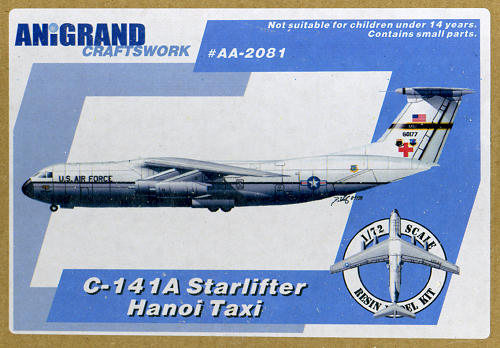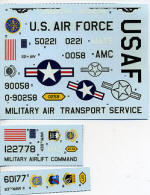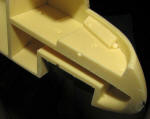
Anigrand 1/72 C-141A Starlilfter
| KIT: | Anigrand 1/72 C-141A Starlilfter |
| KIT #: | AA-2081 |
| PRICE: | $173.00 from Anigrand USA. Free shipping in US |
| DECALS: | One option |
| REVIEWER: | Scott Van Aken |
| NOTES: | Resin kit with metal landing gear |

| HISTORY |
In the early 1960s, the United States Air Force Military Air Transport Service relied on a substantial number of propeller-driven aircraft. As these aircraft were mostly obsolescent designs and the Air Force needed the benefits of jet power, the USAF ordered 48 Boeing C-135 Stratolifters as an interim step. The C-135 was a useful stop-gap, but only had side-loading doors and most bulky and outsize equipment would not fit.
In the spring of 1960 the Air Force released Specific Operational Requirement 182, calling for a new aircraft that would be capable of performing both strategic and tactical airlift missions. The strategic role demanded that the aircraft be capable of missions with a radius of at least 3,500 nautical miles (4,000 miles, 6,500 km) with a 60,000 pound (27,000 kg) load. The tactical role required it to be able to perform low-altitude air drops of supplies, and carry and drop paratroops in combat. Several companies responded to SOR 182, including Boeing, Lockheed and General Dynamics.
Lockheed responded to the requirement with a unique design: the Lockheed Model 300, the first large jet designed from the start to carry freight. The Model 300 had a swept high-mounted wing with four 21,000 pound thrust TF33 turbofan engines pod-mounted below the wings. An important aspect was the cabin floor's height of only 50 in (1.27 m) above the ground, allowing easy access to the cabin through the rear doors. The two rear side doors were designed to allow the aircraft to drop paratroopers (in August 1965 the type performed the first paratroop drop from a jet-powered aircraft). The rear cargo doors could be opened in flight to allow airborne freight drops. The shoulder-mounted wings gave internal clearance in the cargo hold of 10ft (3.05m) wide, 9ft (2.74m) high and 70ft (21.34m) long. The size enabled the Starlifter to carry, for example, a complete LGM-30 Minuteman ballistic missile in its container. The aircraft was capable of carrying a maximum of 70,847 lbs over short distances, and up to 92,000 lbs in the version configured to carry the Minuteman, which stripped other equipment. The aircraft could also carry up to 154 troops, or 123 fully-equipped paratroopers.
The prototype and development aircraft then began an intensive operational testing program including the first delivery to MATS on the 19 October 1964 to Tinker Air Force Base, Oklahoma. Testing continued and a Federal Aviation Authority type certificate was awarded on 29 January 1965. The first delivery to an operational unit was on the 23 April 1965 to Travis Air Force Base, California. Although operational testing continued the Air Force needs due the involvement in South Vietnam soon had aircraft involved in operational sorties to the combat zone.
Since the airframe was shown to fill up before it reached it load carrying capability, nearly all extant C-141A airframes were lengthened 23 feet with fuselage plugs fore and aft of the wing. These were designated C-141B and part of the modification included air to air refueling capabilities. The modifications to the remaining 270 aircraft was accomplished between 1977 and 1982, effectively adding 60 airframes worth of carrying capacity to the fleet.
On 16 September 2004 the C-141 left service with nearly all active duty USAF units, being confined to reserve units for the remainder of its service life. As of 25 September 2005, there were only eight C-141 aircraft still flying (all from the 445th Airlift Wing at Wright-Patterson AFB). In 2004, 2005, and 2006, the C-141s stationed at WPAFB participated in missions to Iraq and Afghanistan, mostly for the medical evacuation of wounded service members.
One of these last eight aircraft was the Hanoi Taxi (tail number 66-0177 and subject of this kit), which was one of the same aircraft used in 1973, for Operation Homecoming in the final days of the Vietnam War, to repatriate AmericanPOWs from North Vietnam. Though no longer a C-141A as it was in 1973, the Air Force repainted this aircraft in the same livery as it wore in 1973 as the final year of Starlifter operations approached.
With the 2006 announcement of the retirement of these last eight C-141s, the Hanoi Taxi embarked on a series of flights, giving veterans, some of whom flew out of captivity in this aircraft, the opportunity to experience one more flight before retirement. At 9:30 AM on Saturday, 6 May 2006, the Hanoi Taxi landed for the last time and was received in a formal retirement ceremony at the US Air Force Museum. The Hanoi Taxi is now part of the permanent static display collection of the Museum.
| THE KIT |
 This is another monster resin kit from our friends at Anigrand. This is the short fuselage C-141A variant, with a near identical C-141B also being offered. In fact, all the B bits (well, the IFR receptacle) is included in this kit. Molded in Anigrand's usual tan resin with nicely engraved detailing, the kit itself is actually relatively basic. The fuselage is molded in four sections as it just makes it easier to box like that. I have found that Anigrand's method of attaching fuselage sections is quite sturdy and works very well.
This is another monster resin kit from our friends at Anigrand. This is the short fuselage C-141A variant, with a near identical C-141B also being offered. In fact, all the B bits (well, the IFR receptacle) is included in this kit. Molded in Anigrand's usual tan resin with nicely engraved detailing, the kit itself is actually relatively basic. The fuselage is molded in four sections as it just makes it easier to box like that. I have found that Anigrand's method of attaching fuselage sections is quite sturdy and works very well.
The wings are upper and lower sections and pretty well free from warping, not an easy task in this scale. Pylons and engines also have large attachment points to make it easier to connect these items. The fin has the usual T-tail with a central fairing into which the two stabilizers fit. The cockpit has a compete loadmaster station as well as the usual flight engineer, pilot, co-pilot and navigator's positions. This is all covered by a nicely done clear canopy. Anigrand has learned from earlier kits and provides a very nicely done set of metal landing gear. There is also sufficient space to cram in the weight as this one will probably need quite a bit.
 Instructions are well done with seven photo-realistic images that show where all the bits fit. Decals come from a variety of other kits including the C-117 kit with a small sheet designed just for this particular aircraft. The decals are nicely printed and with the large, relatively flat surfaces, should work very well. Though these stick well, past experience has shown that they do not 'snuggle down' in to the various panel lines and crevices, even with help from setting solution.
Instructions are well done with seven photo-realistic images that show where all the bits fit. Decals come from a variety of other kits including the C-117 kit with a small sheet designed just for this particular aircraft. The decals are nicely printed and with the large, relatively flat surfaces, should work very well. Though these stick well, past experience has shown that they do not 'snuggle down' in to the various panel lines and crevices, even with help from setting solution.
 This particular kit also comes with a CD that shows both interior and exterior details of the C-141 to help with the construction of the kit. The CD is only available for a very limited time.
This particular kit also comes with a CD that shows both interior and exterior details of the C-141 to help with the construction of the kit. The CD is only available for a very limited time.
I would be remiss not to mention that this kit shows the usual array of molding glitches from resin blobs to myriad pin holes and some relatively large voids, all of which will need to be taken care of if one wishes a contest level model. For that reason alone, this kit is not for the beginner but one who has several of the smaller kits under their belt.
| CONCLUSIONS |
As mentioned, this is for the very experienced builder, but if one is used to taking care of the prelilminaries before building, then one will be rewarded with a superb model. And face it, there are darn few kits of this or any of Anigrand's other subjects around. Their C-17 sold out VERY quickly and I fully expect this one to do so as well.
| REFERENCES |
http://en.wikipedia.org June 2008
My thanks to www.NostalgicPlastic.com for the preview kit. Get your's at the link and pay no shipping in the US and Canada. If you would like your product reviewed fairly and fairly quickly, please contact the editor or see other details in the